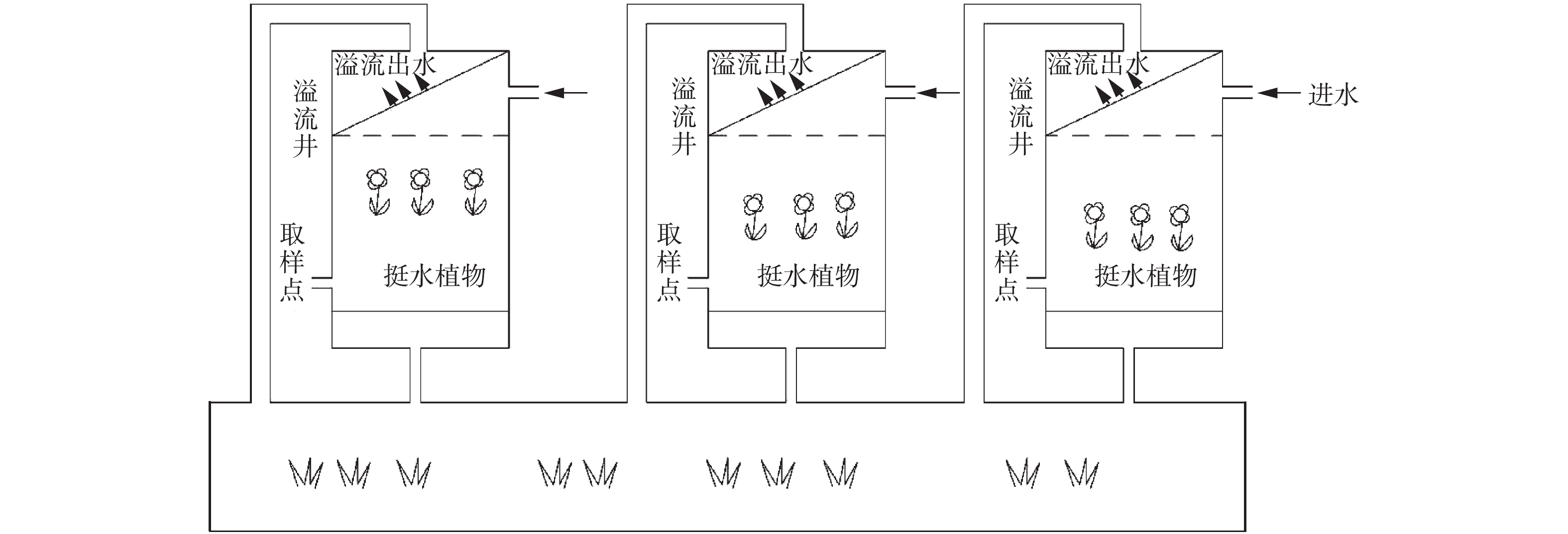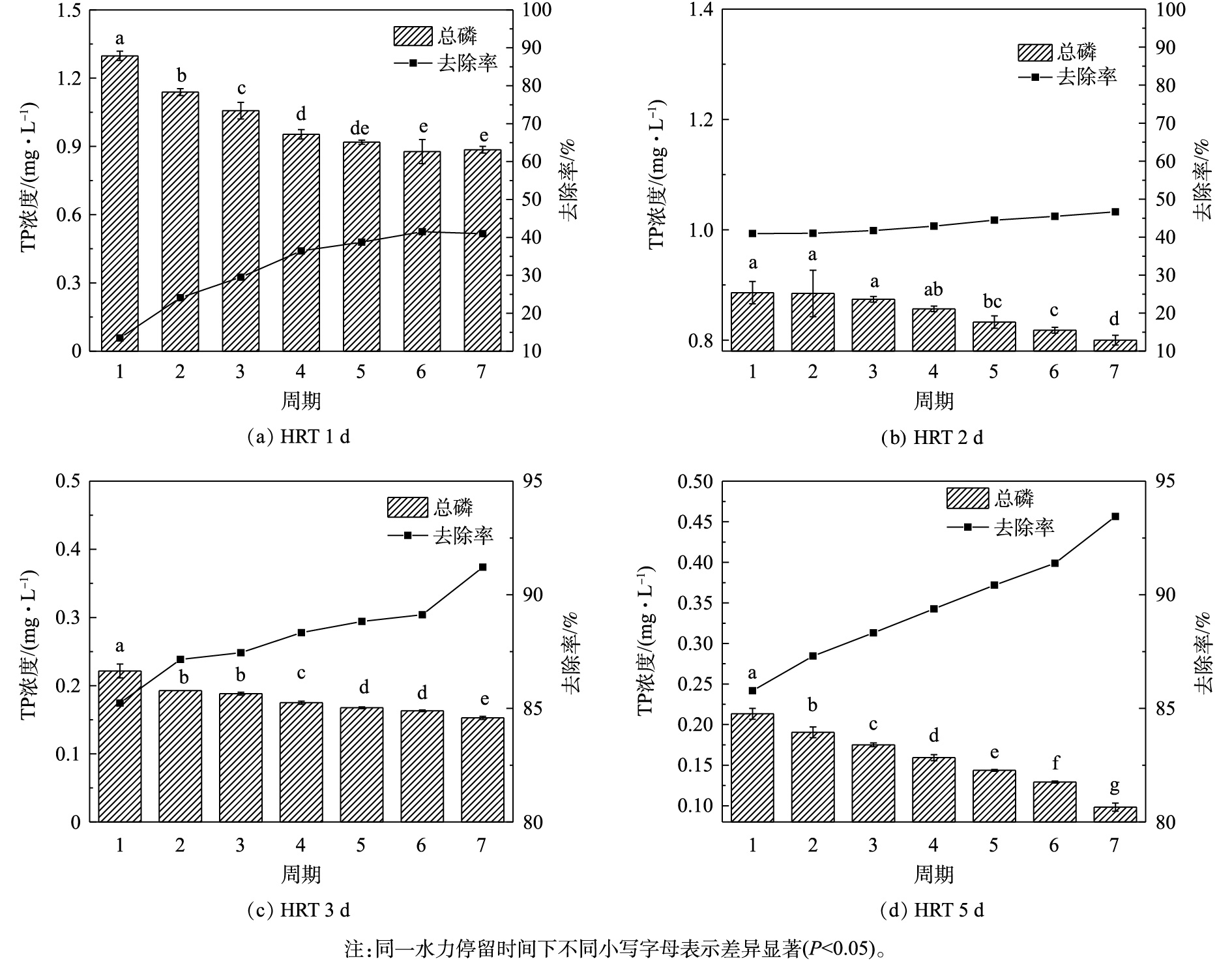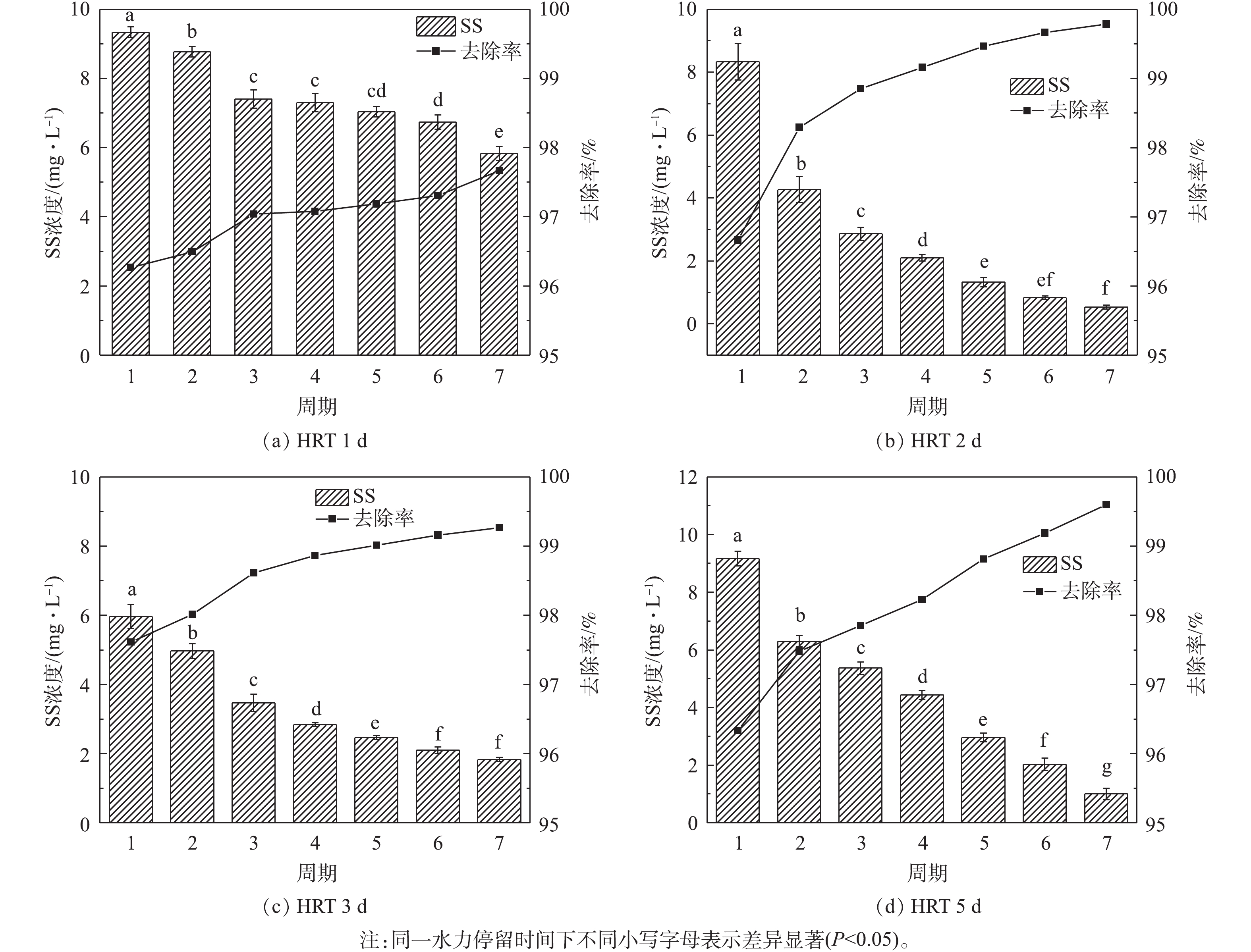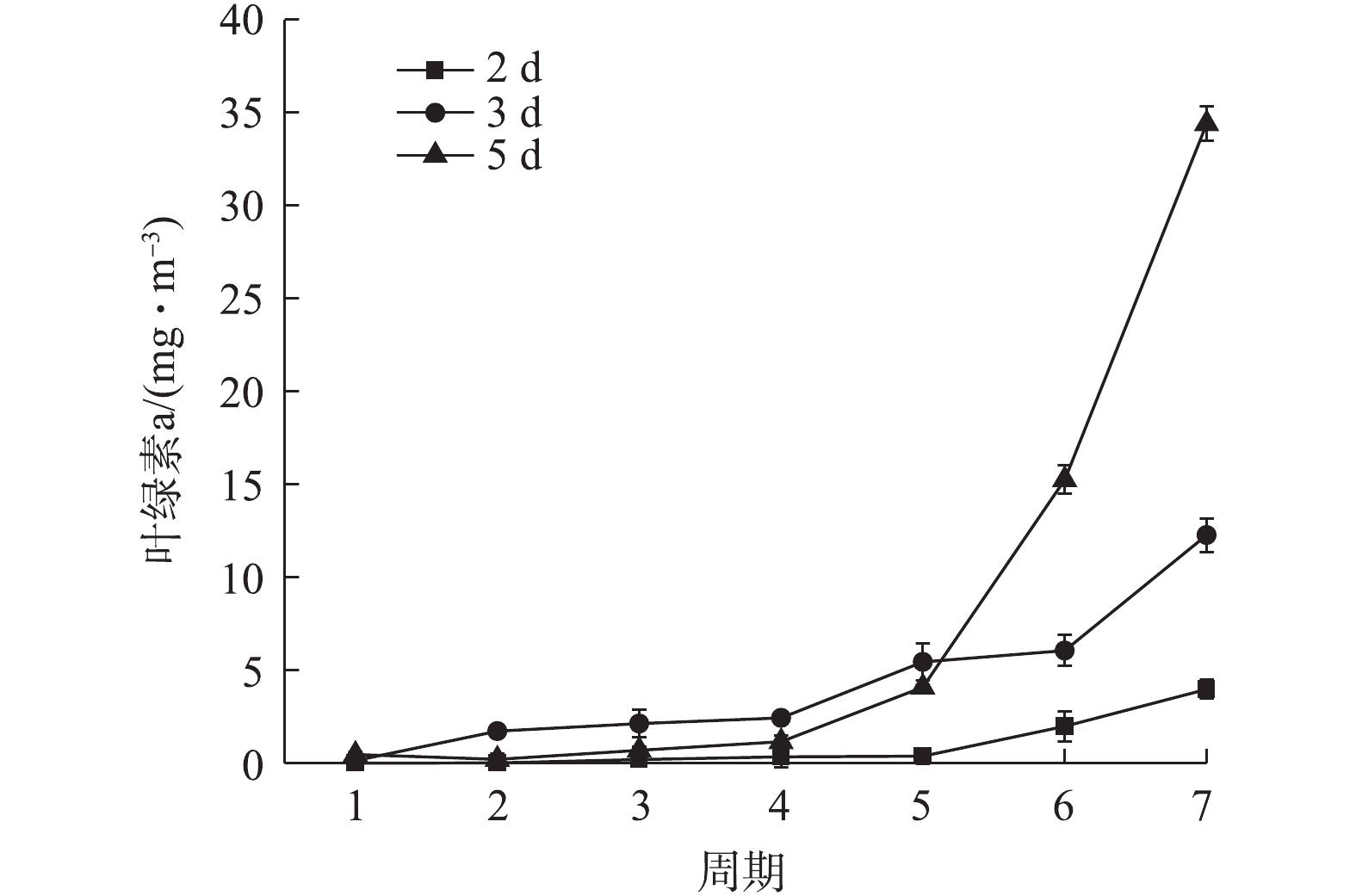-
集中居住区初期地表径流是指中大雨量降雨初期(前10~15 min)在硬质化地面汇聚而成的水流。农村集中居住区缺乏适宜的径流处理设施,污染物浓度较高的初期地表径流常常直接排入河道,引发受纳水体或河道支浜的富营养化问题[1]。据报道,在降雨量达6~8 mm时,径流中的污染物浓度占整场雨量的60%;当降雨量达到10 mm时,污染物占据了80%[2]。近年来,农村水环境问题愈加严重:一是枯水期水资源短缺,但丰水期地表径流大量汇集却无处可去,引起了农民生活区内涝;二是初期地表径流给受纳水体带来的非点源污染的问题[3]。由此可见,采取对农村初期地表径流实施污染拦截与强化净化的措施,从源头上控制进入自然水体的污染负荷很有必要。
为了高效率、低成本地解决农村初期地表径流的“就近处理-原位净化”的问题,本研究借鉴人工湿地的运行原理,设计了“集水花坛-拦截沟”的组合工艺,并开展了模拟实验,研究了该组合工艺对地表径流的净化效果。在集水花坛装置中,搭配种养不同品种的观赏性水生植物,花坛底部设置微型储水池,以满足非降雨期水生植物对于水分的需求;设置溢流堰,排出降雨后期的清水径流,并连接拦截沟,实现地表径流的强化净化。本研究通过实验装置的设计及对实验数据的分析,探讨了农村地表径流“就近处理-原位净化”思路的可行性,为农村初期地表径流的处理提供技术参考和数据支撑。
全文HTML
-
如图1所示,参考《人工湿地污水处理技术导则》(RISN-TG 006-2009)[4],初期地表径流收集处理装置分为3个部分:溢流井起到“蓄混排清”的分流作用,完成对初期地表径流的收集,并将后期的清水径流通过溢流方式排入拦截沟;集水花坛利用植物与微生物的联合净化作用,对收集的初期地表径流进行处理;拦截沟对集水花坛出水及后期清水径流进行强化净化处理。模拟装置集水花坛的处理水量采用0.5 m2的硬质化地面上收集的初期地表径流的水量[5],大约为6 L。每3个模拟装置集水花坛后设置1个拦截沟,用于收集处理后的初期地表径流和后期清水径流,以进行强化净化处理。
-
模拟装置集水花坛中选用的水生植物有2种:再力花(Thalia dealbata Fraser),竹芋科再力花属,多年生挺水植物;美人蕉(Canna indica L),美人蕉科美人蕉属,多年生挺水植物,每个花坛中种上等量的再力花和美人蕉,初始生物量均为(150±0.57) g;拦截沟主要种植黑麦草(Lolium perenne L),每个拦截沟中种植0.1 m2的黑麦草。这3种植物均要洗净,在自配雨水中预培养驯活5 d,待苗成活后,移种到装置中进行水质净化处理。实验装置中植物生长所需光源由光照培养架上的灯管提供[6],培养架每层配有4支灯管(25 W,2 500 lx),光照时间设置为12 h。实验室温度控制在26 ℃左右。设计水力停留时间(HRT)分别为1、2、3和5 d,每种HRT设置3组平行,供开展7个周期的运行实验。在每个周期采样后,将装置内水体清空并重新注入原实验水样。
在常州市武进区前黄镇运村的村示范工程建设地(31°33′52.97″ N,119°58′48.18″ E)现场,采集初期地表径流,测定其相关水质指标作为参考,采用人工配制实验水样,模拟初期地表径流中的水质指标浓度如下:TN为(10±0.50) mg·L−1、TP为(1.50±0.05) mg·L−1、COD为(100±1.09) mg·L−1、SS为(250±1.14) mg·L−1。
-
实验水样测定的水质指标包括化学需氧量(COD)、总氮(TN)、总磷(TP)、悬浮物(SS)及叶绿素a(Chla)。TN、TP采用Skalar San连续流动分析仪测定;COD采用重铬酸钾法测定;SS采用0.45 μm滤膜过滤称重法测定;叶绿素a采用95%的乙醇萃取法[7]测定。
在实验开始与结束时,分别测定植株株高、根长、生物量、全氮、全磷。采用混合催化剂硫酸消化凯式滴定法测定植物干物质全氮;采用硫酸高氯酸消煮钼锑抗比色法测定植株干物质全磷[8]。
-
实验数据取3个平行样品的平均值,由均值±标准差表示,采用SPSS Statistics 20对数据进行方差及相关性比较,分析在各水力停留时间下的水质指标之间的差异,采用One-way ANOVA进行单因素方差分析,选用LSD检验和Duncan’s检验显著性差异,使用Origin9.0绘图。
水生植物氮、磷的含量根据式(1)和式(2)进行计算。
式中:AN为单位面积的植株氮含量,g·m−2;AP为单位面积的植株氮含量,g·m−2;Qd为植株干质量,g·m−2;CN为植株干物质中全氮质量分数;Cp为植株干物质中全磷质量分数。
1.1. 实验装置
1.2. 实验材料与方法
1.3. 分析方法
1.4. 数据处理
-
1)不同HRT处理对径流中TN去除效果的影响。水力停留时间(HRT)与水中污染物的去除效果有直接关系[9-10]。由图2可知,在4种不同的HRT下,集水花坛对TN的去除率大小顺序为3 d>5 d>2 d>1 d(P<0.05)。当HRT为3 d时,从第5个周期开始,TN的去除率基本保持平稳(P>0.05)且达到了90%以上,水质达到了《地表水环境质量标准》(GB 3838-2002)[11]Ⅲ类水标准,且净化效果显著优于其他HRT下的处理效果(P<0.05)。在HRT为1 d时,由于时间过短,TN的去除率均小于20%,随着时间的延长,去除率并没有显著提升(P>0.05)。在HRT为2 d和5 d的处理中,在第6、7个实验周期中,对TN的去除率均达到60%以上,对径流中的含氮污染物产生了明显的净化效果,相较于同周期的HRT为3 d时的TN去除率仍有显著差异(P<0.05),且HRT为3 d时,去除效果更佳。初期地表径流经集水花坛处理后,排入拦截沟进行强化净化,TN去除率可上升5%~20%,HRT为1 d时的TN去除率明显好于其他3组处理(P<0.05)。在HRT为3 d时,TN的去除率达到最高,且体系在短时间内可稳定运行;随着HRT的延长,TN去除率会有所降低,这说明此实验条件下集水花坛的最佳运行时间为3 d。
本实验中对于氮的去除主要是通过植物根系的同化作用转化为自身组织[12-13];通过微生物的硝化-反硝化作用[14-15]以及NH3的挥发进入大气。实验发现,随着植物生物量的增长,水中的氮含量明显下降,与李林锋等[16]的研究结果一致。美人蕉与再力花根系发达且密布不定根,是微生物生长繁殖的主要场所,同时附着在根系上的污染物可为微生物提供碳源,增强了根系与水体固-液界面上的硝化反硝化脱氮作用[17-18]。
2)不同HRT处理对径流中TP去除效果的影响。由图3可知,集水花坛对径流中TP的去除率依次为5 d>3 d>2 d>1 d(P<0.05)。在HRT为1 d和2 d时,TP的去除率在系统稳定后达到40%~50%,对水中含磷污染物产生了一定的去除效果,但水中TP含量仍较高,约为0.8 mg·L−1,远远超过地表水Ⅴ类水标准。在HRT为3 d和5 d的处理中,集水花坛对径流中TP的去除率达到85%以上,到第7个周期时,对TP的去除率达到90%以上,水质均达到Ⅲ类水的标准,通过对每个周期的比较发现,HRT为5 d时明显好于3 d时的TP去除效果(P<0.05);7个周期后,TP的去除率仍有上升趋势。HRT为5 d的处理对TP的去除率最高,可能由于较长的HRT有利于径流中的磷素向基质的微孔表面进行扩散,进而增加磷素向吸附点靠近的概率[19],同时,有助于颗粒物在基质中的沉降富集。因此,当地表径流中含有较多磷素污染物时,可通过适当延长水力停留时间来实现更好的除磷效果。后期将径流排入拦截沟中进行持续净化,水中TP的去除率可达到75%~96%。
“集水花坛-拦截沟”组合工艺对于磷的去除主要分为生物和化学作用[20],包括植物自身吸收、微生物转化、基质层的吸附以及极少量磷的挥发[21]。其中,集水花坛实验装置中设有多层基质层,可通过吸附作用有效拦截净化径流水体中的磷素。
3)不同HRT处理对径流中COD去除效果的影响。由图4可知,集水花坛装置能够有效降低径流中的COD,在不同HRT的COD的去除率依次为3 d>5 d>2 d>1 d(P<0.05)。在HRT为2、3与5 d处理中,从第4个周期开始,COD变化趋于稳定(P>0.05),且去除率达到75%以上。这说明当HRT为2~5 d时,集水花坛对水中有机污染物的去除效果良好。当HRT为3 d时,水质达到了地表水Ⅲ类水以上,去除率达到80%以上,明显高于其他3个HRT处理(P<0.05)。将集水花坛处理后的水排入拦截沟进一步净化,去除率总体达到78%以上,HRT为3 d时,水质经强化净化后到达了地表水Ⅱ类水的标准。
通常,降低水中有机污染物的方法有物理法、化学法和生物法[22],“集水花坛-拦截沟”组合工艺主要是通过物理法和生物法来降低COD。不溶性有机污染物通过基质层过滤、截留,从而被径流水体中的微生物降解利用;可溶性有机污染物的一部分被截留在基质层,另一部分通过植物吸收作用和根系生物膜的代谢作用来去除[23],最终完成有效降低径流水体中耗氧有机污染物浓度的目标。
4)不同HRT处理对径流中SS去除效果的影响。由图5可知,集水花坛通过植物和基质层的拦截作用能够较好地去除初期地表径流中的悬浮物。在不同HRT处理下,实验装置从第1个周期开始,对SS的去除率均达到96%以上。随着时间的延长,拦截效果均维持在较高的水平上,且在任何一个HRT下,去除率均较高并且不存在明显差异(P>0.05)。由于SS的去除效果很好,故在拦截沟内对该指标不做测定。在装置长期运行后,如果发生填料堵塞,可通过反冲洗、人工清淤或更换植物来得到缓解。
5)不同HRT处理对径流中藻类物质的生长影响分析。水中藻类物质含量与叶绿素a浓度存在密切的联系,可通过叶绿素a的浓度来基本确定藻含量[24]。通常情况下,藻含量与叶绿素a的浓度成正相关[25],所以当水中叶绿素a增加时,说明藻含量也在不断上升。图6给出了HRT为2、3和5 d时,水中叶绿素a浓度的变化情况。HRT为1 d时,由于停留时间过短,水中藻类物质生长含量太少,故叶绿素a浓度难以检出可忽略不计。随着HRT的延长,从第5个周期开始,叶绿素a的浓度成倍增长(P<0.05),这表明水中藻类含量显著增加。当藻类含量过多时,会导致水中溶解氧显著降低[26-27],对水生生物的活动产生负面影响,故HRT不宜设置过长。
-
由表1可知,经过7个周期的运行实验后,美人蕉与再力花生长状况均良好,其株高、根长均有所增加,尤其是在HRT为3 d和5 d的2个处理中,植物株高增加趋势尤为明显(P<0.05)。对比HRT为3 d和5 d 2个处理的植物,其株高、根长无明显差异(P>0.05),可能是由于装置空间的大小限制了根部的生长。随着HRT的提高,水生植物的氮磷含量均呈现先升高后降低的趋势,由此可见,HRT过长,由于集水花坛内水量较少,营养物质有限,对植物生长不利。经测算可知,不同HRT条件下,2种植物全氮、全磷含量均符合植物正常生长所需氮磷标准[28]。
陈永华等[29]的研究表明,植株的生物量与植物氮磷含量有很好的相关性。在本实验中,植株的生物量与其氮磷含量并未表现出明显的相关性。如表1所示,HRT为3 d时,植株生物量达到最大,但植株的氮磷含量却在HRT为2 d时达到最大,且随着HRT的延长逐渐下降。原因可能是当HRT超过2 d时,径流水体开始出现藻类,并且随着停留时间的延长,藻类逐渐增多(图6),与植物产生竞争,吸收部分氮磷物质[30]。另外,HRT超过2 d时,植物根系及径流水体中形成了较多的生物膜,也对氮磷物质产生了降解作用。这些因素在一定程度上降低了植株的氮磷含量。
表2为植物对初期径流中氮磷去除的表观贡献率。在HRT为2 d时,植物的表观贡献率最高,说明此时植物的吸收对水中氮磷的去除作用占主导。随HRT的延长,植物对径流中氮磷去除的表观贡献率有所降低,然而水体氮磷的去除总量依然可观。这说明:当HRT>3 d时,水中的微生物开始在降解过程中发挥主导作用[16];当HRT为3 d时,集水花坛通过植物与微生物联合净化达到了最佳的氮磷去除效果。
由表2可知,随着HRT的延长,植物对水中氮、磷的表观去除率逐渐下降,表明植物的吸收作用对于径流水体中的氮磷去除过程的贡献率有所降低,而植物根系及径流水体中的微生物数量增加,因此,径流中氮磷去除效果反而有所增强。当HRT稳定在3 d和5 d时,水中微生物降解过程对于径流水体中的氮磷去除起主导作用。
2.1. 初期地表径流净化效果分析
2.2. 植物对径流中氮磷的吸收作用
-
1)集水花坛通过植物-微生物联合作用对水体进行净化,在植物生长过程中,植物根系为微生物的生长繁殖活动提供场所;同时,微生物的降解作用有助于将水体有机污染物分解成植物易吸收的离子态形式,使水体环境更有利于植株的生长。植物-微生物联合修复体系可使污染物得到快速降解与去除。
2)“集水花坛-拦截沟”组合工艺利用植物吸收、微生物降解及基质层的吸附拦截等综合作用,可有效降低农村初期地表径流水体中的污染物浓度。在4种不同的HRT下,该工艺均可快速去除径流中的SS,且去除率可达96%以上。当HRT为3 d时,该工艺能够显著降低径流中的TN、TP及COD,去除率分别达到90%、90%和75%以上,为工艺运行的最佳水力停留时间。




 下载:
下载:






